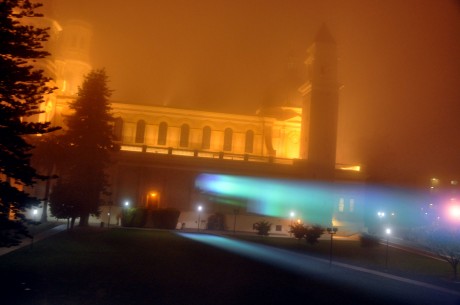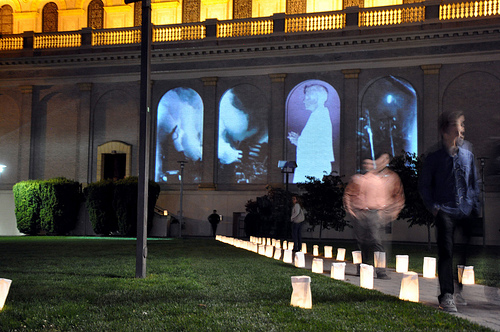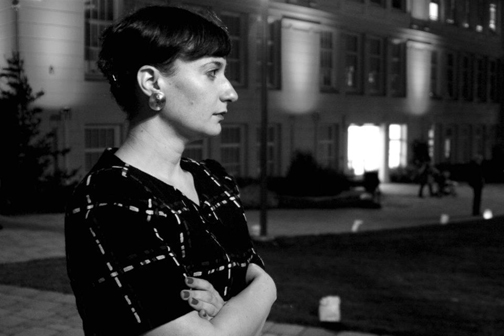
Ben Wood. "Ten Years Later" (9/11 memorial), 2011. Site specific projection, St. Ignatius Church, San Francisco CA. Courtesy the artist. Photo: Michael Nerro
On September 11, 2011, St. Ignatius Church in San Francisco was the site of a 9/11 memorial service and a large-scale projection by British artist Ben Wood. Working closely with curator Tamara Loewenstein, Wood created a melange of images invoking the aftermath of the 9/11 attacks and traditional rituals of remembrance. In this interview Loewenstein and Wood discuss the process of creating something that was equal parts installation, performance, sacred rite and act of communal memory.
Jason Lahman: What was the genesis of the 9/11 memorial project at St. Ignatius and how did you decide to use the exterior of the building?
Tamara Loewenstein: When Ben Wood approached us at Manresa Gallery [the art gallery inside St. Ignatius] with a proposal for a 9/11 memorial, we began to discuss what that might look like. At first we planned an interior illumination using the existing LED lighting system within St. Ignatius Church. However, it became clear that an outdoor public project was more in line with our combined interests. Much of Ben’s work has included large-scale outdoor projections, including four different projections on San Francisco’s historic Coit Tower. Ben and I began to think about who our audience would be and how we would incorporate the architecture of the landmark San Francisco church. We decided on the east wall, which had the most visibility. Conceptually, we were seeking to break down the physical barrier of the wall to reveal the prayerful acts taking place inside the church. The four solid archways were transformed into windows by the projection.

Ben Wood. "Ten Years Later" (9/11 memorial), 2011. Site specific projection, St. Ignatius Church, San Francisco CA. Courtesy the artist. Photo: Madeline Brown
JL: A first responder at “ground zero,” Patrick Tidaback, was a part of this project. What role did he play?
TL: Working with Patrick was such a beautiful experience. When he heard about the plans for this project he contacted Ben directly and ended up providing him with many of the photos used in the finished projection. It was such a privilege to engage in a very moving exchange with someone who had been on the scene. Patrick trusted us with his memories, his photos and his grief. We are so grateful for his involvement.

Ben Wood. "Ten Years Later" (9/11 memorial), 2011. Site specific projection, St. Ignatius Church, San Francisco CA. Courtesy the artist. Photo: Madeline Brown
JL: The finished projection by Ben Wood was quite moving. What was the experience like of executing something so technically demanding and so emotionally charged?
TL: As in the past with other emotionally-charged exhibitions I have curated, it is often not until the project is complete that I am able to experience it for what it really is. Ultimately, it is the presence of the audience that completes a project. Since my attention was so focused on coordinating the technical details of the projection, the emotion of the subject matter became peripheral. It wasn’t until the interfaith memorial service had ended and we all walked outside together to view the projection that I was able to truly see the piece. It is always incredibly satisfying to view such powerful work alongside your audience and to have the opportunity to see it as they do.
JL: There is an abundance of 9/11 imagery, so much of it iconic. How did you decide on these particular images?
Ben Wood: I was contacted by “ground zero” first responder Patrick Tidaback who had learned about the project while researching upcoming memorials. Patrick had brought his camera to the site of the WTC a couple of days after September 11th. The photographs were taken discreetly and with respect and consideration for the magnitude of the tragedy. Later he used some of his photographs as the basis of a series of paintings. After a few meetings with Patrick his work seemed like the perfect choice as the source material for the projection. The moving figure that also appears carrying a candle was inspired by the Jewish custom of Yahrzeit, the yearly ritual of lighting a candle to remember the death of a loved one on the anniversary of their passing.

Ben Wood. "Ten Years Later" (9/11 memorial), 2011. Site specific projection, St. Ignatius Church, San Francisco CA. Courtesy the artist. Photo: Madeline Brown
JL: I’ve been thinking about the presence of buildings in your projection work. Can you speak about your use of buildings and the space around them in the making of your pieces?
BW: The projection and the architecture have to work together to create a whole and this building seemed almost like it was designed as a site for projection. In all of my projects I try to be aware not only of a building’s particular history and how that will play into the meaning of the final piece, but also how people who use that building or see it everyday are going to react to it being used in this way. Those who might not normally be involved with art can be drawn in through a project like this that is very large and very public. St. Ignatius is a religious and an educational facility. It is also a prominent landmark. This made it a perfect choice for this project. Early on we identified the building’s four giant archways as the site of the projection. It almost felt like they were waiting for us.

Ben Wood. "Ten Years Later" (9/11 memorial), 2011. Site specific projection, St. Ignatius Church, San Francisco CA. Courtesy the artist. Photo: Madeline Brown
JL: This work was called a memorial, which can mean either a ritual for the dead or
a physical monument. Can you talk about this work a bit in relationship to either one or both of these ideas? What did it mean for you to be making a memorial?
BW: As an artist one has to carefully consider so many things in the making of a memorial of any sort–whether a ritual or a structure. I’m aware of how a memorial can be used for political ends, rather than for helping people deal with their grief. We wanted to give as wide a range of people as possible a chance to connect to one another even as they remembered the tragedy of that day. That is why I think that the image of the figure with the lighted candle was such a good choice. Candle lighting is a common cross-cultural symbol and we can all relate to the action of lighting a candle or of being at some event where candles have been lit. Beyond all of the political details of the attacks is the fact that we were all dealing with sudden violence and death on a massive scale. If you think about a monument as a place where memory or grief are focused it is almost as if the monument has a voice of its own. The projected images made of light are passing and temporary against the stone. In some ways it was as if the images were giving voice to the building. Thus it was a memorial in both senses of the word: a ritual as well as a structure to recall the lives of those we lost that day.
[youtube:https://www.youtube.com/watch?v=imeYTYDolsA]
[youtube:https://www.youtube.com/watch?v=ycPQ-NefvpE&context=C32c1c96ADOEgsToPDskLAcxQ5GE2iIb7Wz7zPdlmF]





